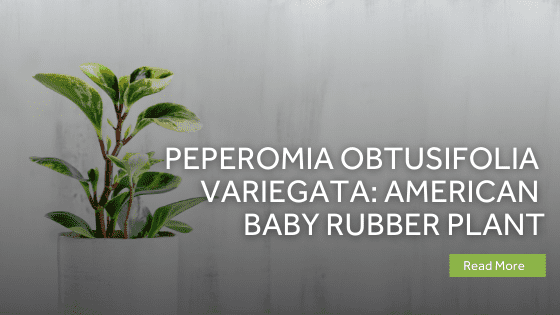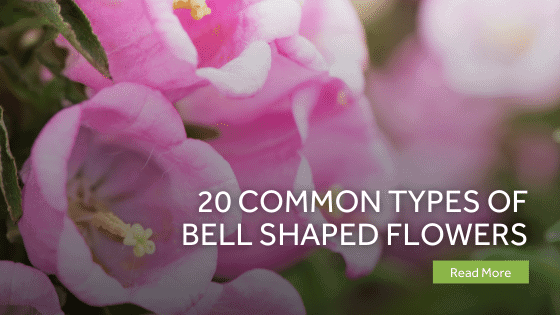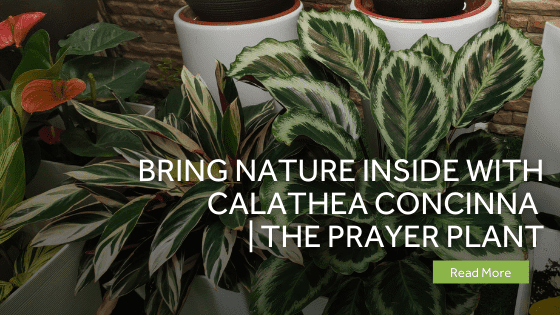The Peperomia Obtusifolia Variegata is a low-maintenance plant that thrives in many different indoor and outdoor settings. The Peperomia Obtusifolia Variegata is a resilient plant that requires little daily maintenance. Also known as the American Baby Rubber Plant, Peperomia obtusifolia variegata plants are resistant to many pests and are tolerant of drought, making them excellent plants for both novice gardeners and those who do not have an active green thumb. If this sounds right up your alley, read on to learn how to properly care for your Peperomia and help it thrive in your home!
Table of Contents
Peperomia Obtusifolia Variegata Overview
There are over 1000 different types of Peperomias. Specifically, the American Baby Rubber Plant is part of the Peperomia Obtusifolia variety. Other common names include the American Baby Rubber Plant, American Rubber Plant, the Dwarf Rubber Plant, or Dwarf Emerald Ripple.
The Peperomia Obtusifolia Variegata has several cultivars (a plant form that has been produced in cultivation by selective breeding) within this species:
P. Obtusifolia “Aquamarine” which can have either green or silver leaves and/or stems
P. Obtusifolia “Variegata,” which has a pale green center surrounded by a thin band of dark green on each leaf
P. obtusifolia “Silver Vein,” which features leaves with prominent veins that appear to be made from silver paint rather than from veins of chlorophyll
The Peperomia Obtusifolia Variegata originates in Central America and the Caribbean and can also be commonly found throughout South America.
| Botanical Name | Peperomia Obtusifolia Variegata |
| Family | Piperaceae |
| Genus | Peperomia |
| Origin | Central America |
| Sunlight | Bright sunlight |
| Watering | Once every ten to fourteen days |
| Soil | Can tolerate a wide range of soil moisture levels |
| Temperature | 65°F to 75°F (18°C to 24°C) |
| Propagation | Leaf cuttings |
| Re-Potting | Once every two to three years |
| Pests and Diseases | Resistant to most pests |
| Toxicity | Non-toxic |
Peperomia Obtusifolia Variegata Features
The Peperomia Obtusifolia Variegata grows to be about 8 inches tall and spreads about 16 inches, with the plant itself growing only 2-4 inches wide. Young Peperomia obtusifolia variegata plants grow with narrow spikes of green leaves that are almost needle-like in appearance; as the Peperomia grows older, its leaves become wider and more rounded. The Peperomia’s green leaves are often tinged with silver or white patches, an attractive feature to gardeners looking for an easy-care plant. In addition, this plant has small pink flowers that dangle on long stalks from the uppermost branches of the plant.
Peperomia Obtusifolia Variegata Care Guide
The Peperomia Obtusifolia is known for its resilience and minimal daily maintenance. Because this plant tolerates a wide range of rooting levels, it does not require being planted deep within the soil or special pots. The Peperomia can thrive when placed inside a pot without drainage holes due to its tolerance for overwatering. Still, only certain cultivars should be kept moist for extended periods of time. If placed outdoors, water whenever the top inch of soil becomes dry, then allow the soil to dry out before watering again. If placed indoors, water when the soil becomes dry to touch.
Ideal Growing Place
For best results, place the Peperomia Obtusifolia Variegata near a bright window with direct light or outdoors in partial to direct sun. If placed indoors, be sure the house is not too warm and nighttime temperatures will remain above 40 degrees Fahrenheit.
This plant thrives when grown indoors in a location with bright, indirect light. If this peperomia is going to be grown under fluorescent lights, keep the lamp only an inch or so away from the leaves and turn on the artificial light 16 hours a day.
Propagation is best carried out during its growing season in the spring and summer.
Water
Peperomia Obtusifolia Variegata is adapted to drought conditions to grow without watering. Keep this plant away from standing water in a pot without drainage holes. Don’t let it wilt by allowing it to dry out too much.
During the summer, watering is usually sufficient, but a lower temperature can reduce the amount of water required. Make sure to water sparingly and let it dry. It is enough to water the plant once every ten to fourteen days in fall and winter. Overwatering can potentially lead to root rot.
Sunlight
Peperomia obtusifolia Variegata needs bright light but be careful not to burn if it receives too much direct sunlight. It can be grown indoors or outdoors in sunny or shady locations.
Temperature
Peperomia obtusifolia Variegata plants do well in warm temperatures ranging from 65 to 75 degrees Fahrenheit. They can tolerate temperatures as low as 40 degrees Fahrenheit, but the leaves may become shriveled. When the temperature exceeds 85 degrees Fahrenheit, the leaves may wilt, and the Baby Rubber Plant flowers may not form.
Soil
Peperomia obtusifolia variegata plants can tolerate a wide range of soil moisture levels. Therefore, deep soil and pot drainage holes are unnecessary to keep this plant happy.
Humidity
Humidity is not a problem for these plants as they adapt to various humidity levels well. However, high humidity levels are Peperomia’s preference. Therefore, when the plants become dry, watch them closely. If needed, lightly mist the plants to keep them hydrated without overwatering. Additionally, the foliage should be well ventilated and not be allowed to remain wet for a long time.
Fertilizer
Peperomia obtusifolia variegata plants do not have special fertilizer requirements. However, it is recommended to use a balanced liquid or slow-release fertilizer diluted to one-fourth the recommended strength every two months when the plant is actively growing. Do not fertilize in fall and winter.
Pinching/Pruning
Remove the parent plant’s leaves from the stems. Stem cuttings should be three inches in length. Use a sharp, clean knife or scissors.
Pipe cleaners can be used to make cylindrical tubes out of paper towel sheets. Place the cuttings inside and label each one, so you know which is which. The lower leaves should touch the bottom of the tube while the upper ones should be left free.
Potting and Re-potting
Unlike many house plants, peperomia obtusifolia variegata does not need to be re-potted often since they can tolerate a wide range of soil moisture levels. Instead, repot once every two to three years.
Growth Zone
Peperomia obtusifolia variegata has growth cycles of about two years. As the plant gets older, you will need to “harden off” or acclimate it outdoors in winter if growing outdoors.
Common Pests, Toxins, Diseases & Other Problems
Generally, this plant is resistant to most pests. Nevertheless, improper care and an unsuitable environment may cause some issues for the plant.
Peperomia Obtusifolia Propagation: Overview
Propagation is best carried out during the warm months of spring and summer. To do this, you will need leaf cuttings from your parent plant and can choose to propagate your Peperomia in either soil or water- both work fine!
If propagating in soil, make sure to keep the soil moist but not wet. If propagating in water, make sure to replace dirty water at least every week to keep the plant nice and healthy. Regardless of the method you choose, the node is the only part of the plant that should be exposed to moisture. Leaves should not be submerged within the water or soil.
A small root system should emerge within a couple of weeks, and the young plant is on its way!
Rooting Compounds
You can use a rooting compound to help with propagation. One recommended product is Rootone F. If you do not have this on hand, substitute a half-and-half mix of rooting hormone and water.
Soil/Growing Medium
Watering is necessary for propagating the variegated Peperomia obtusifolia. Although the plant is drought-resistant, it should be watered thoroughly once every week or two to help develop strong roots, encourage good growth, and prevent leaf drop.
Lighting/Photoperiod (Outdoors)
If propagating Peperomia obtusifolia variegata outdoors, place them in a sunny location. They should be protected from the afternoon sun.
Lighting/Photoperiod (Indoors)
Plants propagated indoors require at least six hours of bright, indirect light daily or filtered sunlight to ensure new growth. Therefore, it is best to place them near a south-facing window to receive the most amount of sunlight throughout the day.
Peperomia Obtusifolia Variegata Mature Timeline
This plant blooms when it’s about one or two years old. It is a slow grower. After the parent plant flowers, cut off its leaves and discard them. This will let your Peperomia focus on growing new stems.
Peperomia obtusifolia Variegata has a very slow growth rate. When it is young, it can be grown outdoors without any problem. Around six months old, you should Yacclimate the plant to colder climates. If your plant is healthy and strong enough, you can leave it outdoor in winter without killing it.
Grower’s Tips
The most important thing about growing Peperomia obtusifolia variegata plants is providing them with the right environment. They are tropical plants, so you should plant them in soil that retains moisture and drains well. The leaves should never be water-logged or soggy! If they are, your plant will die.
Getting rid of air bubbles is very important to prevent the rotting of roots and stem tip cuttings. Therefore, it is highly recommended that you place the cutting in a glass of water with no air bubbles. If you don’t want to use the stem cutting method, you can divide an existing plant into two or more sections and then re-pot each one separately.
How Old Does Peperomia Obtusifolia Variegata Have to Be Before They Bloom?
Peperomia obtusifolia variegata plants are typically grown for their foliage rather than flowers. Therefore it is difficult to determine how old they have to be before producing flowers. Most plants grown indoors produce few to no flowers at all. If you wish for your plant to bloom, place it in a sunny location outdoors during the warmer months of spring and summer.
Peperomia Obtusifolia Variegata FAQ
Is Peperomia Obtusifolia a Succulent?
Although it has succulent stems, Peperomia obtusifolia is not typically classified as a fleshy succulent.
Can You Root Peperomia in Water?
Many people are surprised to learn that it is possible to root peperomia in water. However, some Peperomia obtusifolia varieties are more suitable for this technique than others.
Is Peperomia Obtusifolia Poisonous to Cats and Dogs?
Peperomia obtusifolia variegata is non-toxic to cats or dogs under normal circumstances.
Is Peperomia Obtusifolia Variegata Rare?
Peperomia obtusifolia variegata is not necessarily rare. This plant is commonly grown in greenhouses and on windowsills and hanging baskets worldwide.
Should I Mist My Peperomia Obtusifolia?
Yes, you should mist your Peperomia if it appears dry or if your home is not very humid. Misting allows the thick, fleshy leaves to receive moisture and strengthens the plant.
How Fast Does Peperomia Obtusifolia Grow?
Peperomia obtusifolia grows 1/8 inch per day or 2 inches a month.
How Tall Does Peperomia Obtusifolia Grow?
Peperomia obtusifolia grows 6 inches tall or less but can grow wider width-wise.
The Bottom Line
Peperomia obtusifolia variegata is a beautiful houseplant that is sure to brighten up any living space. It tolerates partial shade and light conditions, making it perfect for your home or office. Propagation is quite simple, and care is not difficult if the plant is regularly watered. It makes an excellent gift for a new homeowner or beginner gardener of any age.
Last Updated on August 23, 2022 by Gustaf Johansson




